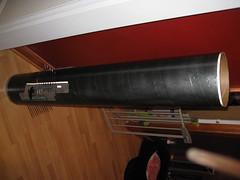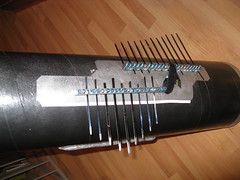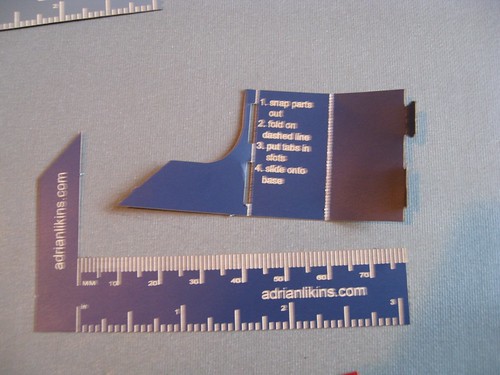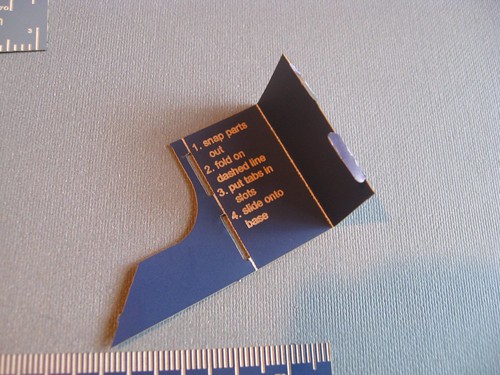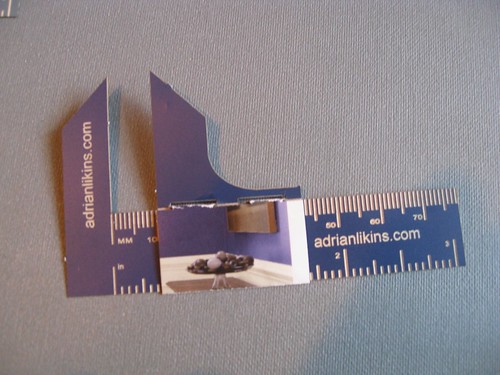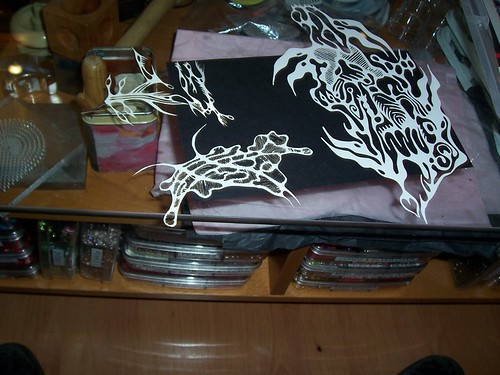Sneak peak of the weapon of choice for the “flushio=0” show tonight 7/23 at Nightlight.
Category Archives: ideas
business card caliper v2
New revision of the card. No big differences except for the slide now includes useful info printed on it, and the instructions go onto the part of the card that doesn’t get used.
Paper with a pattern on top, and white on the back seems to work best for engraving. This was cut on the Epilog laser cutter.
Lots of adjustments trying to get things to fold up nicely with the different papers.
Business card caliper
This is a project I’ve been experimenting with at Techshop Durham. It is a laser cut business card that folds up to create a working caliper. I’ll probably make some for myself, Rod-o-Rama, and lintqueen.
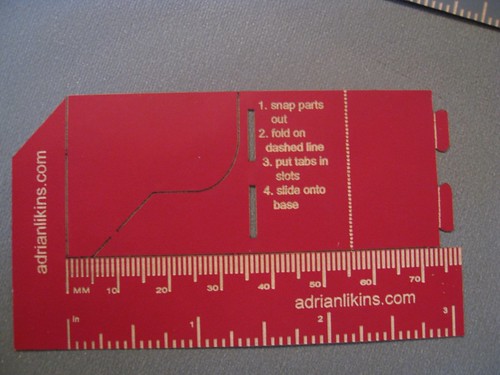
The card in “ready to hand out” mode
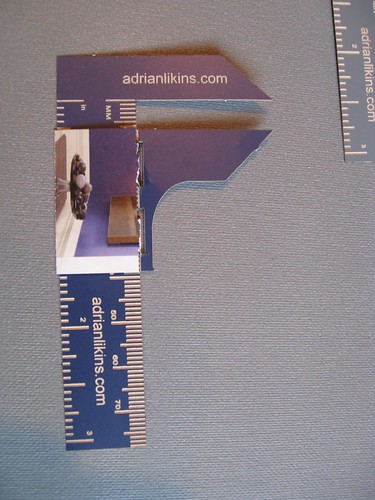
Card assembled, ready to use. These particular examples were actually cut out of paint chip cards (lintqueen’s idea).
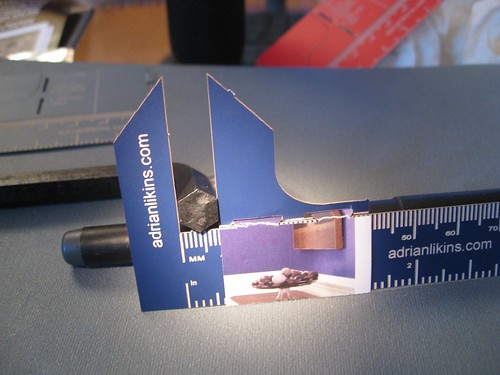
In action, measuring an 8mm hex key. Accuracy and precision are not too bad for something folded out of paper.
It’s cut and engraved with the epilog laser cutter at Techshop Durham. Initial design scratched out on paper, transferred to Inkscape, final tweaking in Corel Draw (actualy, lots of tweaking, since it did a horrible job importing the svg).
It still needs some refinements, like better instructions and possibly an illustration or two. I have some minor aesthetic tweaks in mind as well, but this version is mostly complete.
The corel draw source file is here. That file could use some cleanup, and I’d like to get it back into a open format like svg, but that will do for now. Consider it under Creative Commons.

Business Card Caliper by Adrian Likins is licensed under a Creative Commons Attribution 3.0 United States License.
Based on a work at www.adrianlikins.com.
N sources of nerd guilt
Things that cause tech guilt.
– I should backup more often.
– I should use any/stronger crypto on everything.
– I should really change my password
– I should blog/twitter/facebook/otherwise broadcast desperate attempts to get people to pay attention to me more
– I should blog/etc less
– I should update this system
– I should really automate this task
– I should write this code using WhizBangTech instead of the way that works and I actually know.
– I should optimize this code
– I should document this.
– I should file a bug report about this.
– I really should refactor this code.
Fiddling around with the laser cutter at Techshop. I used inkscape to vectorize some doodles, then cut then out of paper using the Epilog laser cutter at Techshop.
Paper cuts very well, with pretty good detail (see the hatching cut out from the doodle in the front for example). I’ve tried cutting acrylic as well, and it cuts well too, but in some of the detail areas, it unmelts into a bit of a blob that makes detailed parts harder to extract. Need to try it again with more power to see if it will cut a wider kerf.
I also tried engraving/rasterizing an image. I think it turned out pretty well, almost exactly what I was looking for. It did burn through a little bit in one section, but I could fix that in the image. The image itself started off kind of “pointilist”, which I vectorized with some of the settings tweaked a bit so it would blurb some of the points together so it would hold together. Then I “engraved” it instead of cutting it out, but with the power set high enough to burn through the paper.
annoying noise
If there is one skill I have with regards to music, it’s that I make can make some really annoying noises.
While driving home, I started thinking about what would be the most annoying musical instrument one could build. More specially, more or less “acoustic” instruments.[1]
The ideas that came to mind were mostly about building wind instruments, and attaching a large number of them to a compressed air source. Kind of like a set of bagpipes, but far more annoying.
A large pressure chamber with say, three dozen slide whistles attached to it. All slightly out of tune. Or a large number of siren whistles. Or both. Maybe a few dozen cheap penny whistles. Or a hundred kazoos.
Something else to put on the list of things to build.
[1] and not including things that are just brutally loud, like a klaxon, or steam whistle, or a Hemi powered siren, or an orchestra of pulse jets, or maybe a fog horn.
in other words
I was having a discussion with michael over lunch, about other words for “thesaurus”. I could swear I saw one used somewhere that was along the lines of “omnilexigraph” or the like.
Couldn’t find anythough, so I created one. It’s “lexibus”.
Usage example: “‘fabiform’? Thats not a real word! It’s not even in the lexibus!”
gum
I posted a small script I use to help manage the git repo’s of func to github. It’s named gum[1].
The basic idea is you include a gum.conf config file in your repo, that defines where you can find all of the repo’s and branches of the project in question. It’s got a couple of commands to add list the repo’s, add a repo, or add all of the repo’s. It always names the branch in the form remotename-branchname.
I wrote it since it seemed I would end up with a different version of the git repo on every machine I used, and I got tired of tracking down remote and branch names to add them to each src checkout I was using.
[1] mainly to annoy skvidal ;->
reading is hard
I read a lot of mailing lists. Mostly for various open source software projects. Most of them for work.
It would be cool to have a mailing list summary page. The page would scan the mailing lists, and post the content most likely to need attention. For software projects, this is stuff like:
- Patches (http://ozlabs.org/~jk/projects/patchwork/ does this for patches to some degree)
- urls to bug reports
- urls to pastebin or gists sites that are likely to contain errors or patches
- things that look like error messages (segfaults, stack traces, etc)
- links to SCM (either direct urls, or urls to web interfaces, github, bitbucket, etc)
Mailing list archive software could probably do this. Mailman has support for “topics” that are defined by regex’s. But the interface is poor.
And of course, an RSS feed for all of the above would be nice.
votes: collect them all
random idea: Those “I voted” stickers. They should make them official. Serial numbers, limited editions, etc. Kind of like stamps except for no monetary values.
Each state could have their own designs. Each voting round would have a different one.
Worse case someone would vote just so they get a “collectable” sticker.
